

Exercise 4 Exercise 4 Write a discrete event simulation program for a blocking system, i.e. a system with m service units and no waiting room. The offered traffic A is the product of the mean arrival rate and the mean service time. 1. The arrival process is modelled as a Poisson process. Report the fraction of blocked customers, and a confidence interval for this fraction. Choose the service time distribution as exponential. Parameters: m = 10, mean service time = 8 time units, mean time between customers = 1 time unit (corresponding to an offered traffic of 8 erlang), 10 x 10.000 customers. 2. The arrival process is modelled as a renewal process using the same parameters as in Part 1 when possible. Report the fraction of blocked customers, and a confidence interval for this
fraction for at least the following two cases (a) Experiment with Erlang distributed inter arrival times The Erlang distribution should have a mean of 1 (b) hyper exponential inter arrival times. The parameters for the hyper exponential distribution should be p 1 = 0 . 8 , λ 1 = 0 . 8333 , p 2 = 0 . 2 , λ 2 = 5 . 0 . 3. The arrival process is again a Poisson process like in Part 1. Experiment with different service time distributions with the same mean service time and m as in Part 1 and Part 2. (a) Constant service time (b) Pareto distributed service times with at least k = 1 . 05 and k = 2 . 05 . (c) Choose one or two other distributions. 4. Compare confidence intervals for Parts 1, 2, and 3 and try explain differences if any.
Exercise 4 - exact solution Exercise 4 - exact solution • With arrival intensity λ and mean service time s • Define A = λs • Erlangs B-formula A m m ! B = P ( m ) = � m A i i =0 i ! • Valid for all service time distributions • But arrival process has to be a Poisson process DTU 02443 – lecture 5 21
Recommend
More recommend